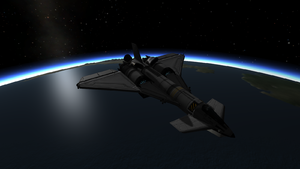Difference between revisions of "Aeris 4A"
m (→Possible improvements: *some links; +more efficient aerospike engine;) |
m (Minor grammatical and factual tweaking.) |
||
| Line 3: | Line 3: | ||
[[File:Aeris 4A in orbit.png|thumb|Another shot in orbit prior to descending.]] | [[File:Aeris 4A in orbit.png|thumb|Another shot in orbit prior to descending.]] | ||
| − | The '''Aeris 4A''' is a manned [[Stock craft|stock spaceplane]] with [[single-stage-to-orbit]] capabilities. With sufficient piloting skill it is capable of reaching [[Kerbin]] orbit, [[docking]] with another craft in orbit and returning safely to the ground without decoupling any parts. | + | The '''Aeris 4A''' is a manned [[Stock craft|stock spaceplane]] with [[single-stage-to-orbit]] capabilities. With sufficient piloting skill it is capable of reaching a 100km circular [[Kerbin]] orbit, [[docking]] with another craft in orbit and returning safely to the ground without decoupling any parts. |
==Features== | ==Features== | ||
| − | The Aeris | + | The Aeris 4A is equipped with two [[TurboJet Engine]]s for atmospheric flight. The [[intake air]] is provided by four [[Radial Air Intake]]s and two [[Ram Air Intake]]s. For orbital flight, one [[LV-T30 Liquid Fuel Engine]] is provided. |
| − | Four [[RV-105 RCS Thruster Block]]s and four [[Place-Anywhere 7 Linear RCS Port]]s for orbital control | + | Four [[RV-105 RCS Thruster Block]]s and four [[Place-Anywhere 7 Linear RCS Port]]s are added for orbital control, allowing both rotational and translational movement. |
| − | With an [[Inline Clamp-O-Tron]] docking port facing upwards it is possible to dock with other craft. | + | With an [[Inline Clamp-O-Tron]] docking port facing upwards, it is possible to dock with other craft. |
==Action Groups== | ==Action Groups== | ||
| Line 28: | Line 28: | ||
Whilst the supplied plane does perform ok, there is some scope for tweaking and/or improving the design, with some quick and easy changes. These are just some basic ideas and things to try out: | Whilst the supplied plane does perform ok, there is some scope for tweaking and/or improving the design, with some quick and easy changes. These are just some basic ideas and things to try out: | ||
| − | * Change the [[LV-T30 Liquid Fuel Engine]] to the [[Toroidal Aerospike Rocket]], to reduce the chance of a tail strike on takeoff and landing, and arguably improve aesthetics. The aerospike engine is also more efficient but has only 81 % of the thrust | + | * Change the [[LV-T30 Liquid Fuel Engine]] to the [[Toroidal Aerospike Rocket]], to reduce the chance of a tail strike on takeoff and landing, and arguably improve aesthetics. The aerospike engine is also more fuel-efficient, but has only 81% of the thrust (still sufficient to achieve a 100km circular orbit from a 20km transition from jets). |
* Change action groups 1 & 2 to toggle the engines, instead of just activating them. | * Change action groups 1 & 2 to toggle the engines, instead of just activating them. | ||
* Remove the [[Inline Advanced Stabilizer]], as it's really not necessary with the changed SAS system. The cockpit now provides both sufficient reaction wheel torque and SAS. Atmospheric handling is arguably improved with less torque. | * Remove the [[Inline Advanced Stabilizer]], as it's really not necessary with the changed SAS system. The cockpit now provides both sufficient reaction wheel torque and SAS. Atmospheric handling is arguably improved with less torque. | ||
Revision as of 22:47, 15 November 2013

The Aeris 4A is a manned stock spaceplane with single-stage-to-orbit capabilities. With sufficient piloting skill it is capable of reaching a 100km circular Kerbin orbit, docking with another craft in orbit and returning safely to the ground without decoupling any parts.
Features
The Aeris 4A is equipped with two TurboJet Engines for atmospheric flight. The intake air is provided by four Radial Air Intakes and two Ram Air Intakes. For orbital flight, one LV-T30 Liquid Fuel Engine is provided.
Four RV-105 RCS Thruster Blocks and four Place-Anywhere 7 Linear RCS Ports are added for orbital control, allowing both rotational and translational movement.
With an Inline Clamp-O-Tron docking port facing upwards, it is possible to dock with other craft.
Action Groups
For faster switching between atmospheric and orbital flight, the Aeris 4A has four action groups predefined:
- Activate turbojet engines
- Activate liquid fuel engine
- Shutdown jet engines, toggle intakes
- Open docking port
Its engines are supposed to be controlled through action groups, not through staging.
Possible improvements
Whilst the supplied plane does perform ok, there is some scope for tweaking and/or improving the design, with some quick and easy changes. These are just some basic ideas and things to try out:
- Change the LV-T30 Liquid Fuel Engine to the Toroidal Aerospike Rocket, to reduce the chance of a tail strike on takeoff and landing, and arguably improve aesthetics. The aerospike engine is also more fuel-efficient, but has only 81% of the thrust (still sufficient to achieve a 100km circular orbit from a 20km transition from jets).
- Change action groups 1 & 2 to toggle the engines, instead of just activating them.
- Remove the Inline Advanced Stabilizer, as it's really not necessary with the changed SAS system. The cockpit now provides both sufficient reaction wheel torque and SAS. Atmospheric handling is arguably improved with less torque.
- Add struts between the cockpit and fuel tank or wings, to reduce flexing around the RCS tank and docking port.
- Add batteries and solar panels, for extended duration orbiting.
- Change the AV-R8 Winglets to Advanced Canards on the nose, and Standard Canard on the tail, for improved handling.
Remember to check the centres of mass and lift after making significant changes, and adjust the wings forwards or backwards to compensate, if necessary.
See also
- Tutorial:Aeris 4A mission, a tutorial on how to launch this craft

